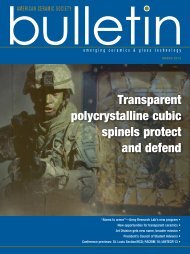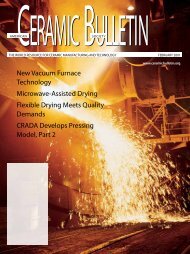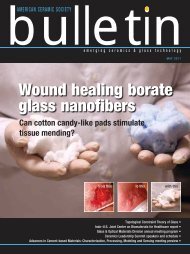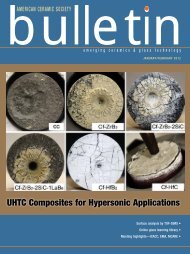AMERICAN CERAMIC SOCIETY
AMERICAN CERAMIC SOCIETY
AMERICAN CERAMIC SOCIETY
You also want an ePaper? Increase the reach of your titles
YUMPU automatically turns print PDFs into web optimized ePapers that Google loves.
esearch briefs<br />
Finding the perfect ink for printing ceramic parts<br />
Inkjet printing techniques are applied<br />
with an increasing number of materials.<br />
In particular, solid freeform fabrication<br />
methods for ceramic materials have<br />
attracted great interest in recent years.<br />
Methods such as stereo lithography,<br />
selective laser sintering and threedimensional<br />
printing are used to produce<br />
complex geometries or parts with material<br />
gradients directly from a digital model.<br />
The technological approach for such<br />
production methods can be divided into<br />
two categories: direct ceramic inkjet<br />
printing and three-dimensional printing.<br />
In the former, an ink containing ceramic<br />
particles is printed onto a substrate,<br />
and the part’s buildup is accomplished<br />
through stacking of printed layers. In the<br />
latter, binder solutions are printed into a<br />
powder bed and bind the loose powder.<br />
Now, D.A. Polsakiewicz and W. Kollenberg<br />
at the Bonn-Rhine-Sieg University<br />
of Applied Science in Germany<br />
have investigated inks for application<br />
in a piezoelectric print head with high<br />
solid content. They prepared and characterized<br />
alumina inks and examined<br />
the influence of various solids loadings,<br />
dispersant concentrations and binding<br />
agents. Their paper appears in Materials<br />
Science and Engineering Technology<br />
(doi:10.1002/mawe.201100780).<br />
Polsakiewicz and Kollenberg found<br />
that a binary mixture of water and ethylene<br />
glycol can serve as a that solvent<br />
system for alumina particles and solvent<br />
properties can be adjusted by varying<br />
composition. As their results reveal,<br />
viscosity as well as shear-thinning<br />
behavior increased with raising solids<br />
content. Rheological behavior of the<br />
inks was not affected by small changes<br />
in particle size or specific surface area.<br />
However, surface tension values varied<br />
depending on the powder used. Supplementary<br />
experiments are necessary to<br />
confirm and understand these results.<br />
Moreover, further printing experiments<br />
are essential for clarification of an<br />
interesting assumption. The researchers<br />
suppose that higher solids loadings also<br />
American Ceramic Society Bulletin, Vol. 90, No. 9 | www.ceramics.org<br />
could be possible without increasing the<br />
viscosity. But they say attention must be<br />
given to increasing shear-thinning characteristics<br />
for higher solids loadings.<br />
(This story first appeared in MaterialsViews.com,<br />
a blog by ACerS publishing<br />
partner Wiley.) n<br />
Does fast firing of multilayer<br />
ceramic capacitors help or<br />
hinder?<br />
A group of investigators led by<br />
Penn State University’s Clive Randall<br />
recently published a paper, “Effect<br />
of Firing Rates on Electrode Morphology<br />
and Electrical Properties of<br />
Multilayer Ceramic Capacitors” in<br />
the Journal of the American Ceramic<br />
Society and available via the Early<br />
View option (doi:10.1111/j.1551-<br />
2916.2011.04880.x).<br />
Because of improved processing over<br />
the past decade, the volumetric capacitance<br />
of multilayer ceramic capacitors<br />
has increased significantly. However,<br />
as devices are miniaturized, their usefulness<br />
is limited by high electrical<br />
leakage, which can be attributed to the<br />
morphology of the electrode–dielectric<br />
interface and microstructural defects,<br />
such as porosity and roughness, at the<br />
electrode–dielectric interface.<br />
Part of the problem on firing MLCCs<br />
is that the barium and titanium (from<br />
the BaTiO 3 dielectric layers) and nickel<br />
(from the electrode layers) form a<br />
low-melting Ba–Ti–Ni alloy that leads<br />
to electrode instabilities. One way to<br />
avoid the problematic alloy formation is<br />
“fast-firing,” i.e., using very high heating<br />
rates to reach the firing temperature.<br />
However, even with fast firing,<br />
the electrode interface is not perfectly<br />
continuous and planar, which limits the<br />
device’s performance.<br />
Previous work had established that<br />
differences in heating rates lead to very<br />
different morphologies. Two batches of<br />
MLCC were cofired at approximately<br />
1280°C for two hours under identical<br />
atmospheres, but at heating rates of<br />
either 150°C per hour or 3000°C per<br />
hour. The team used finite element<br />
analysis to predict the outcomes.<br />
As expected, the continuity of the<br />
electrodes is higher for the fast-fired<br />
batch, and measurements show that<br />
the capacitance of the device also is<br />
higher. Also, impedance measurements<br />
showed that the electrode–dielectric<br />
interface and grain boundaries contribute<br />
to the improved resistance of<br />
the MLCC. (However, the interface<br />
contributes more significantly than do<br />
the grain boundaries). The slow-fired<br />
batch exhibited a higher concentration<br />
of electrode defects, leading to a higher<br />
leakage current and confirming the<br />
group’s FEA predictions.<br />
The group concludes that the interface<br />
plays an important role in MLCC<br />
performance and that electrode morphology<br />
can be controlled to a considerable<br />
extent by processing.<br />
Visit www.mri.psu.edu/centers/CDS<br />
n<br />
3D microstructure of a typical MLCC<br />
fabricated by researchers at Penn State<br />
by the (a) slow-fired conditions and (b)<br />
fast-fired conditions.<br />
(Credit: JACerS.)<br />
19






